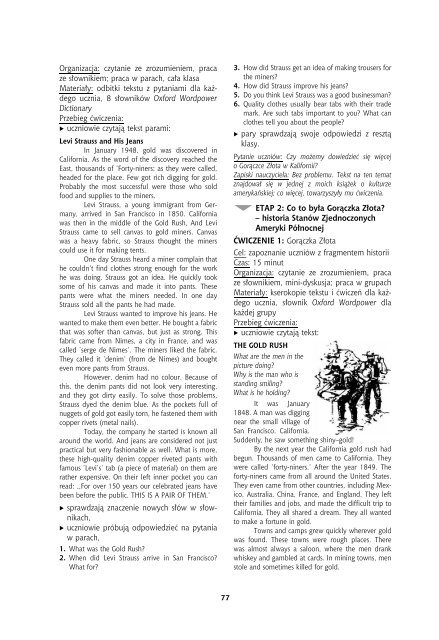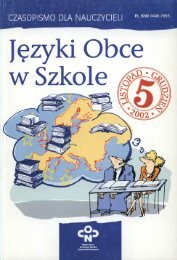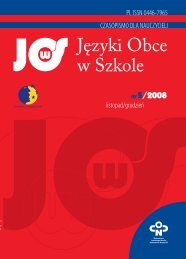PrzeglÄ daj publikacjÄ
PrzeglÄ daj publikacjÄ
PrzeglÄ daj publikacjÄ
- No tags were found...
Create successful ePaper yourself
Turn your PDF publications into a flip-book with our unique Google optimized e-Paper software.
Organizacja: czytanie ze zrozumieniem, pracaze s³ownikiem; praca w parach, ca³a klasaMateria³y: odbitki tekstu z pytaniami dla ka¿-dego ucznia, 8 s³owników Oxford WordpowerDictionaryPrzebieg æwiczenia:Ö uczniowie czytaj¹ tekst parami:Levi Strauss and His JeansIn January 1948, gold was discovered inCalifornia. As the word of the discovery reached theEast, thousands of ’Forty-niners; as they were called,headed for the place. Few got rich digging for gold.Probably the most successful were those who soldfood and supplies to the miners.Levi Strauss, a young immigrant from Germany,arrived in San Francisco in 1850. Californiawas then in the middle of the Gold Rush, And LeviStrauss came to sell canvas to gold miners. Canvaswas a heavy fabric, so Strauss thought the minerscould use it for making tents.One day Strauss heard a miner complain thathe couldn’t find clothes strong enough for the workhe was doing. Strauss got an idea. He quickly tooksome of his canvas and made it into pants. Thesepants were what the miners needed. In one dayStrauss sold all the pants he had made.Levi Strauss wanted to improve his jeans. Hewanted to make them even better. He bought a fabricthat was softer than canvas, but just as strong. Thisfabric came from Nimes, a city in France, and wascalled ’serge de Nimes’. The miners liked the fabric.They called it ’denim’ (from de Nimes) and boughteven more pants from Strauss.However, denim had no colour. Because ofthis, the denim pants did not look very interesting,and they got dirty easily. To solve those problems,Strauss dyed the denim blue. As the pockets full ofnuggets of gold got easily torn, he fastened them withcopper rivets (metal nails).Today, the company he started is known allaround the world. And jeans are considered not justpractical but very fashionable as well. What is more,these high-quality denim copper riveted pants withfamous ’Levi’s’ tab (a piece of material) on them arerather expensive. On their left inner pocket you canread: ,,For over 150 years our celebrated jeans havebeen before the public. THIS IS A PAIR OF THEM.’Ö sprawdzaj¹ znaczenie nowych s³ów w s³ownikach,Ö uczniowie próbuj¹ odpowiedzieæ na pytaniaw parach,1. What was the Gold Rush?2. When did Levi Strauss arrive in San Francisco?What for?3. How did Strauss get an idea of making trousers forthe miners?4. How did Strauss improve his jeans?5. Do you think Levi Strauss was a good businessman?6. Quality clothes usually bear tabs with their trademark. Are such tabs important to you? What canclothes tell you about the people?Ö pary sprawdzaj¹ swoje odpowiedzi z reszt¹klasy.Pytanie uczniów: Czy możemy dowiedzieć się więcejo Gorączce Złota w Kalifornii?Zapiski nauczyciela: Bez problemu. Tekst na ten tematznajdował się w jednej z moich książek o kulturzeamerykańskiej; co więcej, towarzyszyły mu ćwiczenia.× ETAP 2: Co to była Gorączka Złota?– historia Stanów ZjednoczonychAmeryki PółnocnejĆWICZENIE 1: Gor¹czka Z³otaCel: zapoznanie uczniów z fragmentem historiiCzas: 15 minutOrganizacja: czytanie ze zrozumieniem, pracaze s³ownikiem, mini-dyskusja; praca w grupachMateria³y: kserokopie tekstu i æwiczeñ dla ka¿-dego ucznia, s³ownik Oxford Wordpower dlaka¿dej grupyPrzebieg æwiczenia:Ö uczniowie czytaj¹ tekst:THE GOLD RUSHWhat are the men in thepicture doing?Why is the man who isstanding smiling?What is he holding?It was January1848. A man was diggingnear the small village ofSan Francisco. California.Suddenly, he saw something shiny–gold!By the next year the California gold rush hadbegun. Thousands of men came to California. Theywere called ’forty-niners.’ After the year 1849. Theforty-niners came from all around the United States.They even came from other countries, including Mexico,Australia, China, France, and England. They lefttheir families and jobs, and made the difficult trip toCalifornia. They all shared a dream. They all wantedto make a fortune in gold.Towns and camps grew quickly wherever goldwas found. These towns were rough places. Therewas almost always a saloon, where the men drankwhiskey and gambled at cards. In mining towns, menstole and sometimes killed for gold.77
















